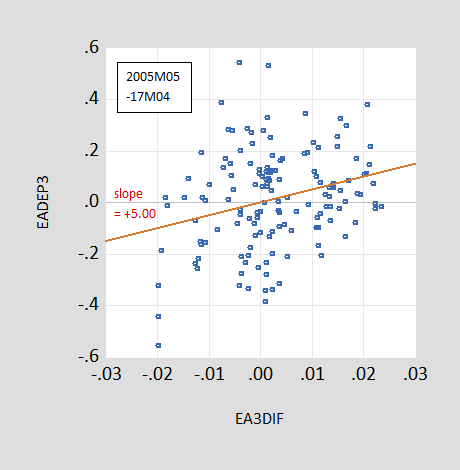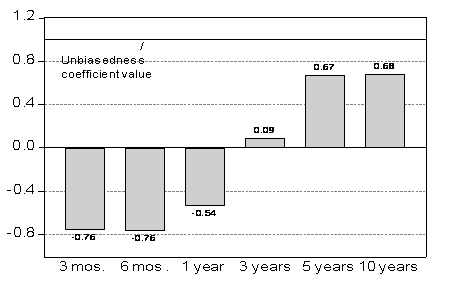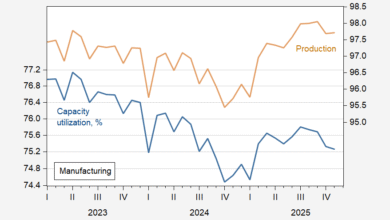
I’ve spent the last week seeing lots of presentations on macro and international finance. Of particular interest are some papers on interest rate parity:
Pablo Cuba Borda, Federal Reserve Board
Martin Bodenstein, Fedral Reserve Board
Nils Gornemann, Federal Reserve Board
Ignacio Presno, Federal Reserve Board
We propose a model with costly international financial intermediation that links exchange rate movements to shifts in the demand for domestically produced goods relative to the demand for imported goods (trade rebalancing). Our model is consistent with stylized facts of exchange rate dynamics, including those related to the trade balance, which is typically overlooked in the literature on exchange rate determination. In a quantitative assessment, trade rebalancing explains nearly 50 percent of exchange rate fluctuations over the business cycle, whereas exogenous deviations from the uncovered interest rate parity— the primary source of exchange rate fluctuations in the literature—account for just above 20 percent. Using data on trade flows or the trade balance is key to properly identifying the determinants of the exchange rate. Thus, our model overcomes the sharp dichotomy between the real exchange rate and the macroeconomy embedded in other models of exchange rate determination.
Discussant:
Federica Romei, University of Oxford
On this first paper, I noted that while the paper was trying to explain the Fama result (forward premia rates do not predict correctly exchange rate depreciation), this is not a constant. From BCCF (IMF ER 2022).
Figure 1: Ex post 3 month annualized depreciation of euro/dollar (vertical axis) against 3 month offshore US-euro interest differential (horizontal axis), for 1999M01-2005M04 (top figure), for 2005M05-2017M04 (middle figure), and 2017M05-2021M06 (bottom figure). Samples pertain to interest rate data, so 1999M01-2005M04 sample includes 3 month ex post depreciation up to 2005M07.
Tarek Alexander Hassan, Boston University and NBER
Thomas Mertens, Federal Reserve Bank of San Francisco
Jingye Wang, Renmin University of China
Canonical long-run risk and habit models reconcile high equity premia with smooth risk-free rates by inducing an inverse functional relationship between the variance and the mean of the stochastic discount factor. We show this highly successful resolution to closed-economy asset pricing puzzles is fundamentally problematic when applied to open economies with complete markets: It requires that differences in currency returns arise almost exclusively from predictable appreciations, not from interest rate differentials. In the data, by contrast, exchange rates are largely unpredictable, and currency returns differ because interest rates differ widely across currencies. We show currency risk premia arising in canonical long-run risk and habit preferences cannot match this fact. We argue this tension between canonical asset pricing and international macroeconomic models is a key reason researchers have struggled to reconcile the observed behavior of exchange rates, interest rates, and capital flows across countries. The lack of such a unifying model is a major impediment to understanding the effect of risk premia on international markets.
Discussant:
Hanno Lustig, Stanford University and NBER
Seunghoon Na, Purdue University
Yinxi Xie, Bank of Canada
This paper investigates exchange rate dynamics and its forecast errors by incorporating bounded rationality in a small open-economy New Keynesian model. Decisionmakers possess limited foresight, capable of planning only up to a finite distance into the future. This yields dynamic overshooting of forecast errors in the real exchange rate across different time horizons. It also distinguishes between short- and long-term expectation formations, where the Law of Iterated Expectations breaks. This framework provides a micro-foundation for understanding time- and forecast-horizon variability in uncovered interest parity (UIP) puzzles. Our model predictions on these UIP violations align both qualitatively and quantitatively with empirical estimates.
Discussant:
Rosen Valchev, Boston College and NBER
I found this paper particularly appealing since I, along with Guy Meredith, found a relationship consistent with this model. In Chinn and Meredith (1998).

Figure 2: Panel beta coefficients at different horizons. Notes: up to 12 months, panel estimates for 6 currencies against US$, euro deposit rates, 1980Q1-2000Q4; 3-year results are zero-coupon yields, 1976Q1-1999Q2; 5 and 10 years, constant yields to maturity, 1980Q1-2000Q4 and 1983Q1-2000Q4 (last observation corresponds to exchange rate data). Source: Chinn (2006).
Some updated results are in this 2022 post.
Source link





